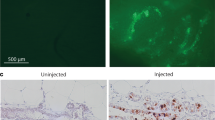Summary
Intraperitoneal inoculation of neonate Sprague Dawley rats with cell-free extracts containing retrovirus-like particles from DMBA-induced rat mammary tumors resulted in a fivefold increase of benign mammary neoplasias in the survivor animals, in comparison to the spontaneous tumor incidence rate. In addition, four animals developed metastasizing abdominal adenocarcinomas. The ascitic cells of one of the abdominal tumors were established as a permanent tissue culture line (HH-1). After subsequent animal passage, cells of the permanent line HH-9 clone 14 showed increased malignancy manifested by the number of takes per animals injected, and by the number of remote metastases observed.
Similar content being viewed by others
References
Bennett D, Peachey LA, Durbin A, Rudland PS (1978) A possible mammary stem cell line. Cell 15:283–298
Bogden AE, Cobb WR, Ahmed M, Alex S, Mason MM (1974) Oncogenicity of the R-35 rat mammary tumor virus. J Natl Cancer Inst 53:1073–1077
Bullock FD, Curtis MR (1930) Spontaneous tumors of the rat. J Cancer Res 14:1–115
Buonassisi V, Sato G, Cohen AI (1962) Hormone-producing cultures of adrenal and pituitary tumor origin. Proc Natl Acad Sci USA 48:1184–1190
Burek JD, Hollander CF (1977) Incidence patterns of spontaneous tumors in BN/Bi rats. J Natl Cancer Inst 58:99–105
Chopra HC, Bogden AE, Zelljadt I, Jensen EM (1970) Virus particles in a transplantable rat mammary tumor of spontaneous origin. Eur J Cancer 6:287–290
Crain RC (1958) Spontaneous tumors in the Rochester strain of the Wistar rat. Am J Pathol 34:311–335
Davis RK, Stevenson GT, Busch KA (1956) Tumor incidence in normal female Sprague-Dawley rats. Cancer Res 16:194–197
Dulbecco R, Bologna M, Unger M (1979) Differentiation of a rat mammary cell line in vitro. Proc Natl Acad Sci USA 76:1256–1260
Engle GC, Shirahama S, Dutcher RM (1969) Preliminary report on virus-like particles in a transplantable rat mammary carcinoma. Cancer Res 29:603–609
Haslam SZ, Bern HA (1977) Histopathogenesis of 7,12-dimethylbenz(a)anthracene-induced rat mammary tumors. Proc Natl Acad Sci USA 74:4020–4024
Hölzel F, Kopp D, Hirche KP, Sakuma S (1981) Ovarian cycle-directed occurrence of particles with retrovirus qualities in DMBA-induced rat mammary tumors. J Cancer Res Clin Oncol (submitted)
Huebner RJ, Todaro GJ (1969) Oncogenes of RNA tumor viruses as determinants of cancer. Proc Natl Acad Sci USA 64:1087–1093
Huggins C, Torralba Y, Mainzer K (1956) Hormonal influences on mammary tumors of the rat. I. Acceleration of growth of transplanted fibroadenoma in ovariectomized and hypophysectomized rats. J Exp Med 104:525–538
Huggins C, Grand LC, Brillantes FP (1961) Mammary cancer induced by a single feeding of polynuclear hydrocarbons, and its suppression. Nature 189:204–207
Lowry OH, Rosebrough NJ, Farr AL, Randall RJ (1951) Protein measurement with the Folin phenol reagent. J Biol Chem 193:265–275
Noble RL, Cutts JH (1959) Mammary tumors of the rat: A review. Cancer Res 19:1125–1139
Ostertag W, Melderis H, Steinheider G, Kluge N, Dube S (1972) Synthesis of mouse hemoglobin and globin mRNA in leukemic cell cultures. Nature New Biol 239:231–234
Owens RB, Hackett AJ (1972) Tissue culture studies of mouse mammary tumor cells and associated viruses. J Natl Cancer Inst 49:1321–1332
Owens RB, Smith HS, Nelson-Rees WA, Springer EC (1976) Epithelial cell cultures from normal and cancerous human tissues. J Natl Cancer Inst 56:843–849
Ratcliffe HL (1940) Spontaneous tumors in two colonies of rats of the Wistar Institute of Anatomy and Biology. Am J Pathol 16:237–254
Richardson UI, Tashjian AH Jr, Levine L (1969) Establishment of a clonal strain of hepatoma cells which secrete albumin. J Cell Biol 40:236–247
Suzuki H, Mohr U, Kimmerle G (1979) Spontaneous endocrine tumors in Sprague-Dawley rats. J Cancer Res Clin Oncol 95:187–196
Thompson SW, Huseby RA, Fox MA, Davis CL, Hunt RD (1961) Spontaneous tumors in the Sprague-Dawley rat. J Natl Cancer Inst 27:1037–1057
Temin HM (1976) The DNA provirus hypothesis. Science 192:1075–1080
Temin HM (1980) Origin of retroviruses from cellular moveable genetic elements. Cell 21:599–600
Author information
Authors and Affiliations
Additional information
Supported by the Deutsche Forschungsgemeinschaft, SFB 34
Rights and permissions
About this article
Cite this article
Hölzel, F., Sakuma, S. & Hanke, D. Origin of a malignant adenocarcinoma cell line induced by retrovirus-like particles from DMBA rat mammary tumors. J Cancer Res Clin Oncol 102, 31–42 (1981). https://doi.org/10.1007/BF00410532
Received:
Accepted:
Issue Date:
DOI: https://doi.org/10.1007/BF00410532




